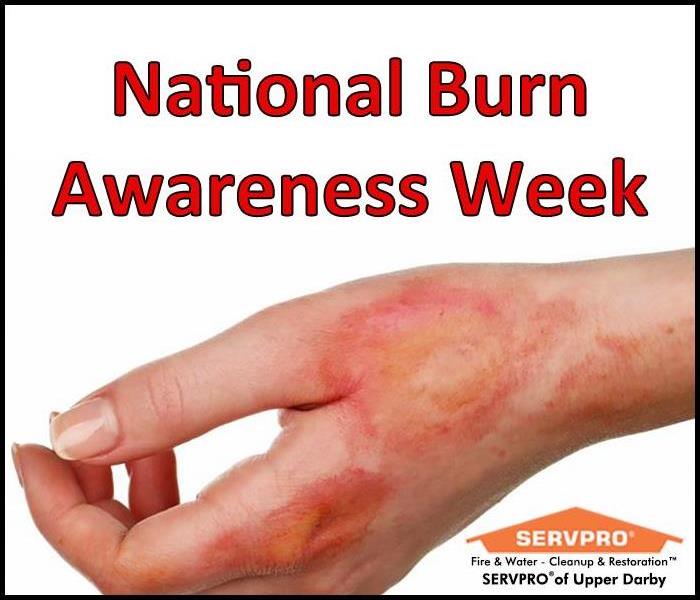National Burn Awareness Week
2/3/2020 (Permalink)
Each year, over 450,000 individuals are seen in emergency departments, clinics, or physician’s offices for the treatment of a burn injury in the United States and Canada. In 2014 alone, there were 3,275 recorded deaths from fire and smoke inhalation injuries. The majority of these injuries are preventable. The American Burn Association strives bring awareness to the causes of such devastating and costly injuries and encourages everyone to make simple environmental and behavioral changes that can save lives.
The following facts and tips are meant to be shared and we hope you will use them and pass them on to help spread the word on the dangers that exist and what can be done to decrease the risk.
Contact Burns
A contact burn is a burn caused by touching a hot object.
TIPS ON AVOIDING A CONTACT BURN
- Supervise children around hot objects at all times.
- Protect your feet from hot objects by wearing shoes when walking on hot pavement or sand. Keep pets off hot pavement too.
- Stand at least 3 feet away from hot outdoor objects. Keep area clear of trip hazards. Limit alcohol consumption.
- Turn heating pads and blankets off before sleep.
- Have hot pads available whenever cooking. Long oven mitts are best when needing to reach in or over hot surfaces, such in an oven or over a grill. Assume all pots and pans are hot.
- Remember to treat items coming from the microwave as you would items from the oven. Limit microwave use by children.
- Unplug tools such as these when not in use, and always treat as if they are still hot. Keep out of reach of children
FACTS
- Roughly 70,000 people went to the hospital emergency department because of contact burns in 2018 (National Electronic Injury Surveillance System- NEISS).
- About one-third of the patients were children under the age of five (5).
Non-Fire Cooking Burns
Most burns associated with cooking in 2013-2017 were caused by contact with a hot object or liquid rather than by fire or flame.
TIPS
- Have a “kid-free zone” of at least 3 feet (1 meter) around the stove and areas where hot food or drink is prepared or carried.
- Never hold a child while you are cooking, drinking a hot liquid, or carrying hot foods or liquids.
- Keep hot foods and liquids away from table and counter edges.
- Ranges or ovens were the most common cooking equipment involved in non-fire cooking burns. Only 14% of thermal burns involving ranges or ovens were due to fire or flame.
- Although tableware is not itself used for cooking, it often holds very hot food, soups or drinks, and may itself be very hot.
- Keep hot foods and liquids away from table and counter edges.
FACTS
- Children under five face a higher risk of non-fire cooking burns. These young children account for 6% of the population but much larger percentages of non-fire burn injuries from cooking equipment, tableware such as bowls and cups, and cookware such as pots and pans.
- In contrast to the non-fire burn estimate, reported home structure fires caused by cooking killed 530 people and injured 5,270 people. This was a fraction of total burn injuries caused by cooking, hot food, or hot drinks. Children under five accounted for only 6% of home cooking fire deaths and 3% of home cooking fire injuries. Cooking was still the leading cause of home fire injuries in the under 5 age group.
Non-Fire Cooking Burns Seen at Emergency Rooms 2013-2017 Annual Averages
- Contact with hot range or oven - 15,700
- Cookware scald – 13,500
- Tableware scald – 9,900
- Contact with hot cookware – 9,400
- Contact with hot grill – 5,200
- Microwave oven scald – 5,200
- Range or oven scald – 3,900
Percent of Non-Fire Cooking-Related Burns Seen at Emergency Rooms 2013-2017 by Children Under 5
- Tableware Scald – 55%
- Contact with hot range or oven – 34%
- Contact with hot grill – 22%
- Microwave oven scald – 20%
- Cookware scald – 12%
- Range or Oven scald – 9%
SERVPRO of Upper Darby
SERVPRO of Upper Darby is here to minimize the effects of a fire on both your home and your life. Our certified professionals are available 24 hours a day, 7 days a week with specialized equipment, expertise, and empathy to get you through this crisis.





 24/7 Emergency Service
24/7 Emergency Service